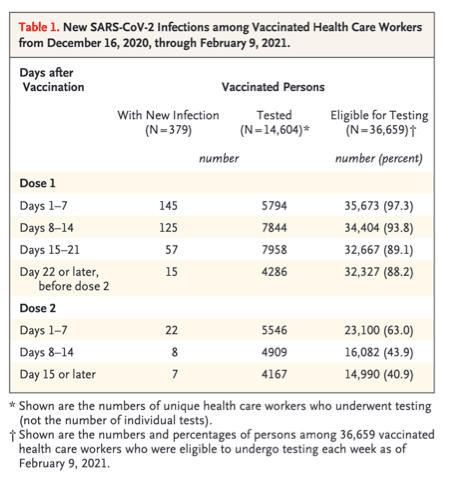| |
Prevents COVID Infection ? - CDC Real-World Study Confirms Protective Benefits of mRNA COVID-19 Vaccines
|
| |
| |
Study involved health care personnel, first responders, and essential workers in six states.
https://www.cdc.gov/media/releases/2021/p0329-COVID-19-Vaccines.html
A new CDC study provides strong evidence that mRNA COVID-19 vaccines are highly effective in preventing SARS-CoV-2 infections in real-world conditions among health care personnel, first responders, and other essential workers. These groups are more likely than the general population to be exposed to the virus because of their occupations.
The study looked at the effectiveness of Pfizer-BioNTech and Moderna mRNA vaccines in preventing SARS-CoV-2 infections among 3,950 study participants in six states over a 13-week period from December 14, 2020 to March 13, 2021.
Results showed that following the second dose of vaccine (the recommended number of doses), risk of infection was reduced by 90 percent two or more weeks after vaccination. Following a single dose of either vaccine, the participants’ risk of infection with SARS-CoV-2 was reduced by 80 percent two or more weeks after vaccination.
It takes about two weeks following each dose of vaccine for the body to produce antibodies that protect against infection. As a result, people are considered “partially vaccinated” two weeks after their first dose of mRNA vaccine and “fully vaccinated” two weeks after their second dose.
-----------------------------------------
SARS-CoV-2 Infection after Vaccination in Health Care Workers in California
Only 8 health care workers tested positive 8 to 14 days after the second vaccination, and 7 tested positive 15 or more days after the second vaccination (Table 1). As of February 9, a total of 5455 health care workers at UCSD and 9535 at UCLA had received the second dose 2 or more weeks previously; these findings correspond to a positivity rate of 0.05%. In our cohort, the absolute risk of testing positive for SARS-CoV-2 after vaccination was 1.19% among health care workers at UCSD and 0.97% among those at UCLA; these rates are higher than the risks reported in the trials of mRNA-1273 vaccine1 and BNT162b2 vaccine.
To the Editor:
Data from phase 3 clinical trials of messenger RNA (mRNA) vaccines through November 2020 showed 94.1% efficacy for the prevention of symptomatic severe acute respiratory syndrome coronavirus 2 (SARS-CoV-2) infection at 14 days after the second dose of the mRNA-1273 vaccine (Moderna)1 and 95% efficacy at 7 days after the second dose of the BNT162b2 vaccine (Pfizer).2 Since the results of these trials were published, a nationwide surge in coronavirus disease 2019 (Covid-19) has been noted, SARS-CoV-2 variants with increased infectivity have emerged, the Food and Drug Administration has granted emergency use authorization for these two mRNA vaccines, and vaccination has been initiated across the United States.
Since the start of the vaccination campaign, the development of Covid-19 has been reported in persons who have received one or both doses of vaccine.3 Both the University of California, San Diego (UCSD) and the University of California, Los Angeles (UCLA) health systems began to vaccinate health care workers on December 16, 2020. On December 2, in addition to defining a low threshold for testing of symptomatic persons, UCSD mandated that asymptomatic health care workers undergo weekly testing by polymerase-chain-reaction (PCR) assay of nasal swabs. On December 26, UCLA instituted an optional testing program for asymptomatic health care workers with PCR assay of nasal swabs. This program has allowed for increased detection of asymptomatic SARS-CoV-2 infections after vaccination.
Pooled data were obtained in deidentified format from an electronic employee health record system at UCSD and UCLA.4 Exemption from institutional review board approval was obtained.

From December 16, 2020, through February 9, 2021, a total of 36,659 health care workers received the first dose of vaccine, and 28,184 of these persons (77%) received the second dose. Among the vaccinated health care workers, 379 unique persons tested positive for SARS-CoV-2 at least 1 day after vaccination, and the majority (71%) of these persons tested positive within the first 2 weeks after the first dose. After receiving both vaccinations, 37 health care workers tested positive; of these workers, 22 had positive test results 1 to 7 days after the second dose. Only 8 health care workers tested positive 8 to 14 days after the second vaccination, and 7 tested positive 15 or more days after the second vaccination (Table 1). As of February 9, a total of 5455 health care workers at UCSD and 9535 at UCLA had received the second dose 2 or more weeks previously; these findings correspond to a positivity rate of 0.05%.
In our cohort, the absolute risk of testing positive for SARS-CoV-2 after vaccination was 1.19% among health care workers at UCSD and 0.97% among those at UCLA; these rates are higher than the risks reported in the trials of mRNA-1273 vaccine1 and BNT162b2 vaccine.2 Possible explanations for this elevated risk include the availability of regular testing for asymptomatic and symptomatic persons at our institutions, a regional surge in infections in Southern California during our vaccination campaigns,5 and differences in demographic characteristics between the trial participants and the health care workers in our cohort. The health care workers were younger and had an overall higher risk of exposure to SARS-CoV-2 than the participants in the clinical trials. In addition, the cutoff dates for reporting in both initial vaccine trials were well before this surge, no testing of asymptomatic persons was included in the BNT162b2 vaccine trial,2 and only a single screening of asymptomatic persons was performed in the mRNA-1273 vaccine trial before the second dose was administered.1
The rarity of positive test results 14 days after administration of the second dose of vaccine is encouraging and suggests that the efficacy of these vaccines is maintained outside the trial setting. These data underscore the critical importance of continued public health mitigation measures (masking, physical distancing, daily symptom screening, and regular testing), even in environments with a high incidence of vaccination, until herd immunity is reached at large.
|
|
| |
| |
|
|
|